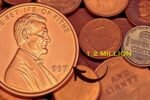The Lincoln Wheat Penny, a small coin minted from 1909 to 1958, might seem ordinary, but a rare version could be worth up to $14 million. Amazingly, some of these valuable pennies may still be hiding in pocket change, coin jars, or old collections. Here’s a simple look at why this penny is so special and how to spot one.
What Makes the Lincoln Wheat Penny Special?
Introduced in 1909 to celebrate Abraham Lincoln’s 100th birthday, this penny was the first U.S. coin to feature a president’s portrait. Designed by Victor David Brenner, it has Lincoln’s face on the front and two wheat stalks on the back, giving it the “Wheat Penny” name. While most are worth just a cent, certain rare versions with errors or low mintage are treasures.
The $14 Million Penny: The 1943 Copper Penny
The most famous and valuable Lincoln Wheat Penny is the 1943 Copper Penny. During World War II, the U.S. Mint switched to steel pennies to save copper for the war effort. By mistake, a few copper blanks were used, creating ultra-rare 1943 copper pennies. Only about 15–20 are known to exist, making them incredibly valuable. One sold for $1.7 million in 2010, but experts estimate a pristine example could be worth $14 million today due to its rarity and collector demand.
Why Is It So Valuable?
- Rarity: Very few 1943 copper pennies were made, and only one is known from the Denver Mint (1943-D).
- Minting Error: The accidental use of copper instead of steel makes it a collector’s dream.
- Condition: A penny in mint (uncirculated) condition is worth much more.
- Historical Value: Tied to World War II, it’s a piece of American history.
Could It Still Be in Circulation?
Yes, it’s possible! These rare pennies might still be out there because:
- People may not know their value and spend them.
- Old coins from collections or stashes get used by mistake.
- Some have been found in change, like one discovered in a high school cafeteria in 1947, later sold for over $200,000.
How to Spot a Valuable 1943 Copper Penny
- Check the Date: Look for “1943” on the front.
- Magnet Test: Copper pennies don’t stick to a magnet; steel ones do.
- Weight: Copper pennies weigh 3.11 grams; steel ones weigh 2.7 grams.
- Mint Mark: Look for a small “D” (Denver), “S” (San Francisco), or no mark (Philadelphia) under the date. The 1943-D is the rarest.
- Condition: Shiny, unworn coins are worth more.
What to Do If You Find One
- Don’t Clean It: Cleaning can ruin its value.
- Handle Carefully: Hold by the edges and store in a plastic coin holder.
- Get It Checked: Take it to a professional grading service like PCGS or NGC to confirm it’s real.
- Sell Smart: If authentic, sell through trusted auction houses like Heritage Auctions or Stack’s Bowers for the best price.
A Note on the $14 Million Claim
While some articles mention values like $14 million or even higher (up to $999 million), these figures are often exaggerated or speculative. The highest verified sale for a 1943 copper penny was $1.7 million, with estimates for a perfect example reaching $5.5 million to $14 million in today’s market. Claims of $110 million or more lack evidence and should be viewed cautiously.
Final Note
The Lincoln Wheat Penny worth $14 million is like a hidden treasure, much like the rare Yamaha XS750 or a shiny Kia Seltos in a crowded lot. It’s rare, but possible, to find one in your change. Next time you see an old penny, check the date and test it with a magnet. That little coin could be your ticket to a fortune! For more on rare coins, visit pcgs.com or ngccoin.com. Happy hunting!



